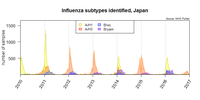Modelling the Evolution of Seasonal Influenza
Seasonal influenza viruses are easily spread between people and constantly evolve into new forms against which there is limited immunity. They circulate around the world, infecting a large number of people every year, largely driven by seasonal effects and existing patterns of immunity to previous strains.
Influenza infection forms a substantial burden on the world’s health and economy, and can have severe health implications for individuals in specific risk groups, such as the elderly, pregnant women, or those who are immunocompromised or suffering from poor nutrition.
Our work focusses on modelling the spread and persistence of seasonal influenza subtypes and strains to address specific public health needs. These include:
- Forecasting the severity of forthcoming influenza seasons
- Improving surveillance, through understanding the geographical and demographic drivers of strain emergence
- How should multivalent influenza vaccines be tailored to best protect communities or populations?
The project will combine a range of models considering different aspects of seasonal influenza evolution and persistence of strains. We will work towards developing large-scale representations of human connectivity, at both national and regional scales, incorporating connectivity patterns arising from travel and from social interaction patterns, such as age-assortative mixing.
Using such models, we intend to simulate the spread and mutation of seasonal influenza subtypes to recreate phylogenetic relationships and investigate the demographic and connectivity information required to reproduce observed patterns.


